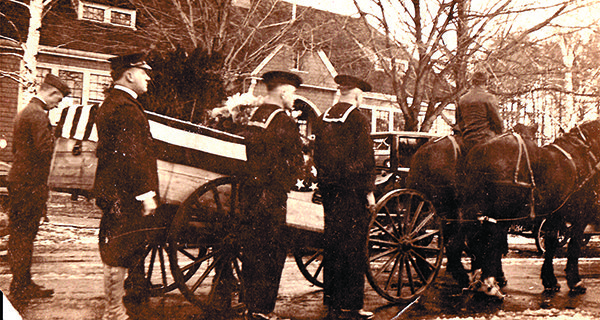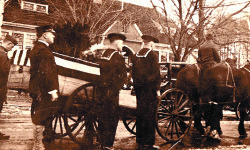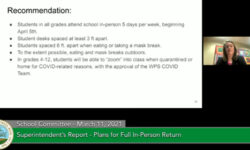By James Kinneen
Hometown Weekly Reporter
COVID-19’s impact on a variety of industries has been one of the most common media stories of the past five months. From what the loss of elective surgeries meant to hospitals, to whether bars and restaurants could survive lockdowns, to how much money, if any, the airlines deserved from the government, any industry effected by the coronavirus was extensively covered by the media.
But one industry that has received very little coverage, despite the huge impact COVID has had on it, is the funeral industry. After reaching out to individuals at a handful of local funeral homes, including Tom Caruso of Roberts-Mitchell-Caruso Funeral Home, Kevin Greene of Eaton Funeral Homes, Jim Delaney of James H. Delaney and Son Funeral Home and Bob Folsom of Folsom Funeral Service, a few patterns emerged.
To the question of what COVID's biggest impact has been on the funeral industry, every person I spoke to immediately brought up the social distancing restrictions that have been placed upon them.
“The main way has been the reduction of the number of people that can attend services, both in the funeral home and at church. That has created some difficulties,” explained Bob Folsom. “We were initially allowed to have ten people in the funeral home. And then in phase two, that changed to 40 percent of our capacity, but that was also subject to being able to seat people six feet apart. For example, if your capacity was 100 people, you could have forty people, but if the room isn’t big enough to keep them six feet apart, you might only be able to have 25 people.”
Other than the crowds being smaller, there are a couple other ways the processions are different. Aside from obvious answers like masks, hand sanitizer usage and staying six feet apart, Tom Caruso noted that older people have been avoiding the crowds, likely out of fear of COVID.
“We’re at a point now that we know that most of the people that are older, mid-60s and up, aren’t going to come to any type of gathering, whether it’s visiting hours or a speech someone’s making. They’re going to opt out. So that’s changed your traditional visiting hours.”
Much like everything that can be held outside is being moved outdoors for both the increased space and free air flow, cemeteries have become a place where larger crowds than before have gathered.
“We were able to gather at the cemetery, since when you’re outside you can social distance,” Caruso explained. “That’s been kind of a game-saver as far as families are concerned, since when you’re outside you can practice social distancing.”
While the distancing and smaller crowds have been difficult, the travel restrictions have also had a negative effect on the grieving process. Close friends and family members from out of state have to deal with quarantines, which would mean either not going to the funerals or having to say in Massachusetts for long periods of time.
“I think the hardest thing for families regarding that is the people who can’t travel because they can’t get flights or would have to quarantine either when they get here or go home,” noted Bob Folsom. “That has meant a lot of people have not come from out of state. That’s tough for people that are grieving; to not have all their family members with them at that time, or to be the family member that can’t come.”
Because of the restrictions, people have adapted in a variety of ways. One of the more common moves is waiting to have a larger ceremony later.
“We have a lot of families that have opted for cremation, and they are waiting until the state opens up for being able to travel into it, to schedule their services," Folsom explained. "The people who have had earth burial, the vast majority of them had graveside services, and several were talking about waiting to have a memorial Mass or a celebration of life later on when they could invite everybody.”
Much like everything moved to Zoom during COVID, unsurprisingly, another common action is to stream a service in some way so people can tune in from home.
“What we have been doing is setting up with the church almost like a Zoom or a Skype type thing where there’s a tripod at church, and it would just roll in real time," said Caruso. "Also, Cable 8 (Medfield TV) has kind of jumped in and has aired a few of our funeral Masses.”
While online guest books have been available for a while, Jim Delaney noted with less people showing up in person, he’s seen a large uptick in the number of messages being written.
“I’d say from mid-March to now, there has been a significant uptick in website submissions and condolences left for families. Especially during the initial period when the initial pandemic kind of came, everyone was working from home and there were all the restrictions, I saw a very large uptick in condolences messages because we weren’t having public services. As the phases have started to roll out, there’s still been a significant uptick, but not as much as it was in the very beginning.”
And while funerals haven’t adopted the drive-by style celebrations so many birthday parties have, Kevin Greene of Eaton Funeral Homes did say he’s been asked to drive by the person’s home and saw neighbors offering support.
“A couple of times the families requested we go past their homes on the way to the cemetery, and we did have a couple of occasions where some of the neighbors were out, standing on sidewalks as we went back, to show their support.”
As far as protecting the workers themselves, a few people noted their use of PPE when dealing with bodies, and how people were not allowed to touch the cadavers, kiss them, etc. But even if you died of COVID, most said you could be buried in a suit, since it’s unlikely you would have worn that suit while sick, and that while people were still allowed to bring in mementos like baseball caps, some homes were seeing less of that.
“We’re seeing more video presentation, slideshow types of things,” said Kevin Greene. “We haven’t disallowed anything, but we haven’t seen people bringing in as many memento type objects as before.”
One query universally shot down was whether the those grieving seemed angry or expressed any anger. On social media, you see anger at the government and at people who don’t wear masks or socially distance from many grieving people on the left, while on the right the anger tends to be at the perceived hypocrisy of the amount of people at BLM rallies versus funerals, or the quarantining rules for funeral-goers at civil rights leaders’ services versus those of average Americans. But no person could think of a time when a grieving person expressed anger or frustration at the situation.
As for good new, while in terms of deaths, Tom Caruso bluntly stated, “When we were seeing the spike, we were getting the spike,” most of the people I spoke with said that reflective of the drop in Massachusetts COVID deaths, they are seeing less demand.
“During March and April it got very busy with COVID deaths, but it has significantly dropped off in June and July," Bob Folsom explained. “Which is a positive thing, I think.”
I think so too.























